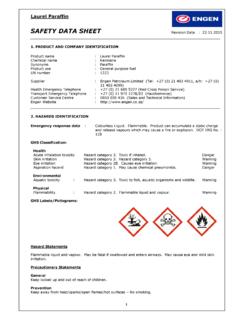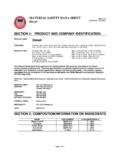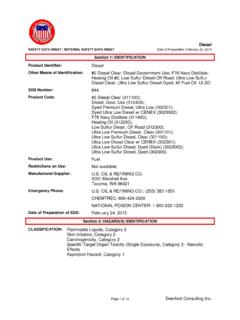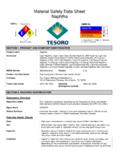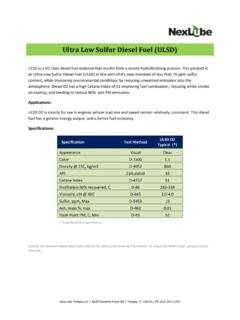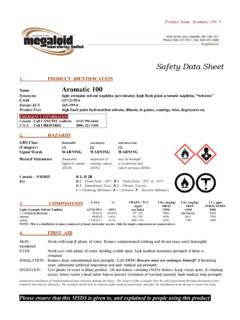Transcription of SAFETY DATA SHEET Revision Date : 12.11
1 Engen Dynamic diesel SAFETY data SHEET Revision date : 1. PRODUCT AND COMPANY IDENTIFICATION. Product name : Engen Dynamic diesel Chemical name : diesel fuel Synonyms : Hydrocarbon Liquid Product use : Automotive diesel fuel UN number : 1202. Supplier : Engen Petroleum Limited (Tel: +27 (0) 21 403 4911, a/h: +27 (0). 21 403 4099). Health Emergency Telephone : +27 (0) 21 689 5227 (Red Cross Poison Service). Transport Emergency Telephone : +27 (0) 11 975 1278/83 (Hazchemwise). Customer Service Centre : 0860 036 436 (Sales and Technical Information).
2 Engen Website : 2. HAZARDS IDENTIFICATION. Emergency response data : Light Amber Liquid. Flammable. Product can accumulate a static charge and release vapours which may cause a fire or explosion. DOT ERG No. : 128. GHS Classification: Health Acute inhalation toxicity Hazard category 3. Toxic if inhaled. Danger Acute oral toxicity Hazard category 5. May be harmful if swallowed. Warning Skin irritation Hazard category 2. Causes skin irritation. Warning Eye irritation Hazard category 2B. Irritant. Warning Carcinogenicity Hazard category 2.
3 Under conditions of poor hygiene and long Warning term exposure, this product should be considered a human carcinogen. Environmental Aquatic toxicity : Hazard category 2. May cause long-term adverse effects in the Warning aquatic environment. Physical Flammability : Hazard category 3. Flammable liquid and vapour. Warning GHS Labels/Pictograms: Hazard Statements Flammable liquid and vapour. Fumes from heated product may cause eye and lung irritation. Toxic if swallowed. Harmful in contact with skin. Note: This product may contain polycyclic aromatic hydrocarbons, some of which have been reported to cause skin cancer in humans under conditions of poor personal hygiene, prolonged repeated contact, and exposure to sunlight.
4 1. Engen Dynamic diesel Precautionary Statements Prevention Do not breathe vapours. Wash exposed skin after handling this product. Do not eat, drink or smoke when using this product. Response IN CASE OF FIRE: Use carbon dioxide, foam or dry chemical for extinction. IF INHALED: Call a POISON. CENTRE or doctor if you feel unwell. IF SWALLOWED: Get medical attention if you feel unwell. IF ON SKIN: If irritation occurs, get medical attention. IF IN EYES: Rinse cautiously with water for several minutes. Disposal Do not discharge into lakes, streams, ponds and ground water supply.
5 See Section 11 for further health effects/toxicological data . 3. COMPOSITION/INFORMATION ON INGREDIENTS. Chemical name CAS-No. Weight%. diesel fuel 68334-30-5 > Ethyl Benzene 100-41-4 < Naphthalene 91-20-3 < See Section 8 for Exposure Limits (if applicable). 4. FIRST AID MEASURES. Inhalation : Remove from further exposure. If respiratory irritation, dizziness, nausea, or unconsciousness occurs, seek immediate medical assistance. If breathing has stopped, assist ventilation with mechanical device or use mouth-to-mouth resuscitation with a mouthpiece.
6 Skin contact : Remove contaminated clothing. Dry wipe exposed skin and cleanse with hand cleaner, soap and water. Launder contaminated clothing before reuse. (See Section 16 - Injection Injury). Eye contact : Flush thoroughly with water for at least 15 minutes. Get medical assistance. Ingestion : Seek immediate medical attention. Do not induce vomiting. Note to doctors : Material if aspirated into the lungs may cause chemical pneumonitis. Skin contact may aggravate an existing dermatitis. Treat appropriately.
7 5. FIRE-FIGHTING MEASURES. Extinguishing media : Carbon dioxide, foam, dry chemical and water fog. Special fire fighting : Water spray should only be used to keep fire-exposed containers cool, procedure flush spills away from exposures, disperse vapours and protect personnel attempting to stop leak. Prevent runoff from fire control or dilution from entering streams, municipal sewers, or drinking water supply. Special protective : For fires in enclosed areas, fire fighters must use Self-Contained equipment for firefighters Breathing Apparatus.
8 Products of decomposition : Fumes, smoke, carbon monoxide, sulphur oxides, aldehydes and other 2. Engen Dynamic diesel decomposition products, in the case of incomplete combustion. Flash Point : > 55 C (ASTM D-93). Upper Explosion Limit (UEL) : 7 %(V). Lower Explosion Limit (LEL) : %(V). NFPA Hazard Id : Health: 1; Flammability: 2; Reactivity: 0. 6. ACCIDENTAL RELEASE MEASURES. Procedure if material is : Report spills/releases as required to appropriate authorities. released or spilled Methods for cleaning up : Eliminate sources of ignition.
9 Warn occupants and/or ships in the downwind areas of fire and explosion hazard, and warn them to stay clear. LAND SPILL: Shut off source taking normal SAFETY precautions. Take measures to minimize the effects on ground water. Recover by pumping using explosion-proof equipment or contain spilled liquid with sand or other suitable absorbent and remove mechanically into containers. If necessary, dispose of absorbed residues as directed in Section 13. WATER SPILL: Notify port and relevant authorities. Confine with booms if skimming equipment is available to recover the spill for later recycling or disposal.
10 If permitted by local authorities and environmental agencies disperse in unconfined waters. If allowed by regulatory authorities the use of suitable dispersants should be considered where recommended in local oil spill procedures. Personal precautions : See Section 8. Environmental precautions : Prevent spill from entering municipal sewers, water sources or low lying areas. Advise the relevant authorities if contaminations have occurred. 7. HANDLING AND STORAGE. Safe handling advice : Keep product away from high energy ignition sources, heat, sparks, pilot lights, static electricity, and open flames.
